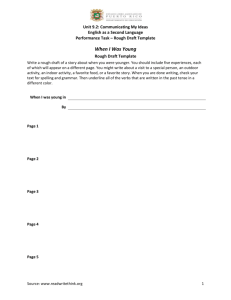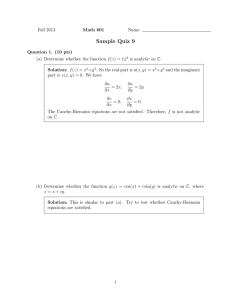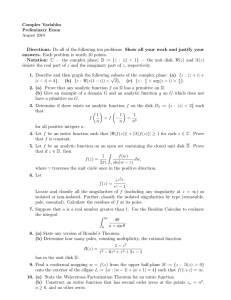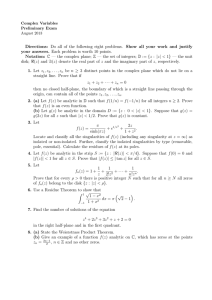MOMENT ESTIMATES FOR SOLUTIONS OF LINEAR STOCHAS- TIONAL BROWNIAN MOTION
advertisement
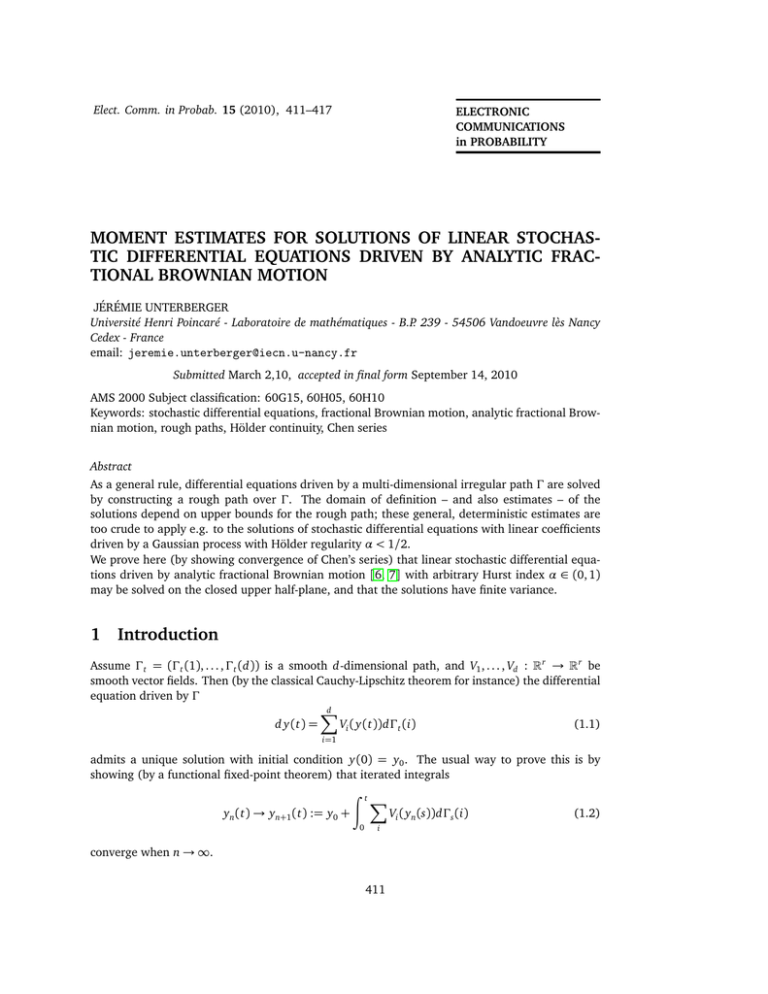
Elect. Comm. in Probab. 15 (2010), 411–417
ELECTRONIC
COMMUNICATIONS
in PROBABILITY
MOMENT ESTIMATES FOR SOLUTIONS OF LINEAR STOCHASTIC DIFFERENTIAL EQUATIONS DRIVEN BY ANALYTIC FRACTIONAL BROWNIAN MOTION
JÉRÉMIE UNTERBERGER
Université Henri Poincaré - Laboratoire de mathématiques - B.P. 239 - 54506 Vandoeuvre lès Nancy
Cedex - France
email: jeremie.unterberger@iecn.u-nancy.fr
Submitted March 2,10, accepted in final form September 14, 2010
AMS 2000 Subject classification: 60G15, 60H05, 60H10
Keywords: stochastic differential equations, fractional Brownian motion, analytic fractional Brownian motion, rough paths, Hölder continuity, Chen series
Abstract
As a general rule, differential equations driven by a multi-dimensional irregular path Γ are solved
by constructing a rough path over Γ. The domain of definition – and also estimates – of the
solutions depend on upper bounds for the rough path; these general, deterministic estimates are
too crude to apply e.g. to the solutions of stochastic differential equations with linear coefficients
driven by a Gaussian process with Hölder regularity α < 1/2.
We prove here (by showing convergence of Chen’s series) that linear stochastic differential equations driven by analytic fractional Brownian motion [6, 7] with arbitrary Hurst index α ∈ (0, 1)
may be solved on the closed upper half-plane, and that the solutions have finite variance.
1
Introduction
Assume Γ t = (Γ t (1), . . . , Γ t (d)) is a smooth d-dimensional path, and V1 , . . . , Vd : R r → R r be
smooth vector fields. Then (by the classical Cauchy-Lipschitz theorem for instance) the differential
equation driven by Γ
d
X
d y(t) =
Vi ( y(t))dΓ t (i)
(1.1)
i=1
admits a unique solution with initial condition y(0) = y0 . The usual way to prove this is by
showing (by a functional fixed-point theorem) that iterated integrals
yn (t) → yn+1 (t) := y0 +
Z
0
t
X
i
converge when n → ∞.
411
Vi ( yn (s))dΓs (i)
(1.2)
412
Electronic Communications in Probability
Expanding this expression to all orders yields formally for an arbitrary analytic function f
f ( y t ) = f ( ys ) +
∞
X
X
Vi1 . . . Vin f ( ys )Γnts (i1 , . . . , in ),
(1.3)
n=1 1≤i1 ,...,in ≤d
where
Γnts (i1 , . . . , in )
Z
:=
t
dΓ t 1 (i1 )
s
Z
t1
dΓ t 2 (i2 ) . . .
s
Z
t n−1
dΓ t n (in ),
(1.4)
s
provided, of course, the series converges. By specializing to the identity function f = Id : R r → R r ,
x → x, one gets a series expansion for the solution ( y t ).
Let
N
X
X
N ,t,s
E V ( ys ) = ys +
Vi1 . . . Vin Id ( ys )Γnts (i1 , . . . , in )
(1.5)
n=1 1≤i1 ,...,in ≤d
be the N -th order truncation of (1.3). It may be interpreted as one iteration of the numerical Euler
scheme of order N , which is defined by
N ,t k ,t k−1
:= EV
y tEuler;D
k
N ,t 1 ,t 0
◦ . . . ◦ EV
( y0 )
(1.6)
for an arbitrary partition D = {0 = t 0 < . . . < t n = T } of the interval [0, T ]. When Γ is only
α-Hölder with N 1+1 < α ≤ N1 , the iterated integrals Γn (i1 , . . . , in ), n = 2, . . . , N do not make sense a
priori and must be substituted with a geometric rough path over Γ. A geometric rough path over Γ
is a family
(1.7)
(Γ1ts (i1 ))1≤i1 ≤d , (Γ2ts (i1 , i2 ))1≤i1 ,i2 ≤d , . . . , (ΓNts (i1 , . . . , iN )1≤i1 ,...,iN ≤d )
of functions of two variables such that: Γ1ts = Γ1t − Γ1s and satisfying a natural Hölder regularity
k
|Γ ts (i1 ,...,ik )|
condition, namely, sups,t∈R
< ∞, k = 1, . . . , N , along with two algebraic compatibility
|t−s|kα
properties (Chen/multiplicativity and shuffle/geometricity properties) for which we refer e.g. to
[2]. To such data one may associate a theory of integration along Γ, so that (1.1), rewritten in its
integral form, makes sense, see e.g. [2] or [3] for local solutions of differential equations in this
setting.
In this article, we prove convergence of the series (1.3) when the vector fields Vi are linear and
Γ is analytic fBm (afBm for short). This process – first defined in [7] –, depending on an index
α ∈ (0, 1), is a complex-valued process, a.s. κ-Hölder for every κ < α, which has an analytic
continuation to the upper half-plane Π+ := {z = x +i y | x ∈ R, y > 0}. Its real part (2Re Γ t , t ∈ R)
has the same law as fBm with Hurst index α. Trajectories of Γ on the closed upper half-plane
Π̄+ = Π+ ∪ R have the same regularity as those of fBm, namely, they are κ-Hölder for every κ < α.
As shown in [6], the regularized rough path – constructed by moving inside the upper half-plane
through an imaginary translation t → t + i" – converges in the limit " → 0 to a geometric rough
path over Γ for any α ∈ (0, 1), which makes it possible to produce strong, local pathwise solutions
of stochastic differential equations driven by Γ with analytic coefficients.
We do not enquire about the convergence of the series (1.3) in the general case (as mentioned
before, it diverges e.g. when V is quadratic), but only in the linear case. One obtains, see section
3:
Main Theorem.
Solutions of linear SDEs driven by fBm
413
Let V1 , . . . , Vd be linear vector fields on C r . Then the series (1.3), associated to afBm Γ with Hurst
index α ∈ (0, 1), converges in L 2 (Ω) on the closed upper half-plane Π̄+ = Π+ ∪ R. Furthermore, there
exists a constant C such that the solution ( y t ) t∈Π̄+ , defined as the limit of the series, satisfies
s, t ∈ Π̄+ .
E| y t − ys |2 ≤ C|t − s|2α ,
(1.8)
The Main Theorem depends essentially on an explicit estimate of the variance of iterated integrals
of Γ proved in Lemma 2.2 below, which states the following:
Lemma 2.2.
There exists a constant C 0 such that, for every s, t ∈ Π̄+ = Π+ ∪ R,
VarΓnts (i1 , . . . , in ) ≤
(C 0 |t − s|)2nα
n!
.
(1.9)
Notation. Constants (possibly depending on α) are generally denoted by C, C 0 , C1 , cα and so on.
2
Definition of afBm and first estimates
We briefly recall to begin with the definition of the analytic fractional Brownian motion Γ, which
is a complex-valued process defined on the closed upper half-plane Π̄+ [6]. Its introduction was
initially motivated by the possibility to construct quite easily iterated integrals of Γ by a contour
deformation. Alternatively, its Fourier transform is supported on R+ , which makes the regularization procedure in [8, 9] void.
Proposition 2.1. There exists a unique analytic Gaussian process (Γ0z , z ∈ Π+ ) with the following
properties (see [6] or [7] for its definition):
(1) Γ0 is a well-defined analytic process on Π+ , with Hermitian covariance kernel
EΓ0z Γ0w = 0,
EΓ0z Γ̄0w =
α(1 − 2α)
2 cos πα
(−i(z − w̄))2α−2 .
(2.1)
+
(2) Let
R γ : (0, 1) → Π be any continuous path with endpoints γ(0) = 0 and γ(1) = z, and set
0
Γz = γ Γu du. Then Γ is an analytic process on Π+ . Furthermore, as z runs along any path in Π+
going to t ∈ R, the random variables Γz converge almost surely to a random variable called again Γ t .
(3) The family {Γ t ; t ∈ R} defines a Gaussian centered complex-valued process, whose covariance
function is given by:
E[Γs Γ t ] = 0,
E[Γs Γ̄ t ] =
e−iπα sgn(s) |s|2α + eiπα sgn(t) |t|2α − eiπα sgn(t−s) |s − t|2α
4 cos(πα)
.
The paths of this process are almost surely κ-Hölder for any κ < α.
(4) Both real and imaginary parts of {Γ t ; t ∈ R} are (non independent) fractional Brownian motions
indexed by R, with covariance given by
E[Re Γs Im Γ t ] = −
tan πα
−sgn(s)|s|2α + sgn(t)|t|2α − sgn(t − s)|t − s|2α .
8
(2.2)
Definition 2.2. Let Yt := Re Γi t , t ∈ R+ . More generally, Yt = (Yt (1), . . . , Yt (d)) is a vector-valued
process with d independent, identically distributed components.
414
Electronic Communications in Probability
The above results imply that Yt is real-analytic on R∗+ .
Lemma 2.3. The infinitesimal covariance function of Yt is:
EYs0 Yt0 =
α(1 − 2α)
4 cos πα
(s + t)2α−2 .
(2.3)
Proof. Let X t := Im Γi t . Since EΓs Γ t = 0, (Ys , s ≥ 0) and (X s , s ≥ 0) have same law, with
covariance kernel EYs Yt = EX s X t = 12 Re Γis Γ̄i t . Hence
1
E[Ys0 Yt0 ] =
2
Re EΓ0is Γ̄0i t =
α(1 − 2α)
4 cos πα
(s + t)2α−2 .
(2.4)
Note that EYs0 Yt0 > 0. From this simple remark follows (see proof of a similar statement in [5]
concerning usual fractional Brownian motion with Hurst index α > 1/2):
Lemma 2.4. Let Ynts (i1 , . . . , in ), n ≥ 2 be the iterated integrals of Y . Then there exists a constant
C > 0 such that
(C|t − s|)2nα
VarYnts (i1 , . . . , in ) ≤ C
.
(2.5)
n!
Proof. Let Π be the set of all pairings π of the set {1, . . . , 2n} such that (k1 , k2 ) ∈ π ⇒ ik10 = ik20 ,
where k10 = k1 if k1 ≤ n, k1 − n otherwise, and similarly for k20 . By Wick’s formula,
VarYnts (i1 , . . . , in )
Z t
Z
X
=
d x1 . . .
π∈Π
s
x n−1
Z
(k1 ,k2 )∈π
Z
x 2n−1
d x n+1 . . .
d xn
s
Y
t
s
d x 2n
s
E[Yx0k Yx0k ].
1
(2.6)
2
Since the process Y 0 is positively correlated, and Π is largest when all indices i1 , . . . , in are equal,
1
(Yt − Ys )n , hence
one gets VarYnts (i1 , . . . , in ) ≤ VarYnts (1, . . . , 1). On the other hand, Ynts (1, . . . , 1) = n!
VarYnts (1, . . . , 1) =
[Var(Yt − Ys )]n
(n!)2
.
(2n)!
2n
. n!
≤
[2Var(Yt − Ys )]n
n!
.
(2.7)
Now (assuming for instance 0 < s < t)
Var(Yt − Ys ) = cα
Z tZ
s
if
t
2
t
(u + v)2α−2 dud v ≤ cα s2α−2 (t − s)2 ≤ cα (t − s)2α
(2.8)
s
≤ s ≤ t, and
Var(Yt − Ys ) =
cα
2α(2α − 1)
if s < t/2. Hence the result.
(2t)2α + (2s)2α − 2(t + s)2α ≤ C t 2α ≤ C 0 (t − s)2α
(2.9)
Solutions of linear SDEs driven by fBm
3
415
Estimates for iterated integrals of Γ
The main tool for the study of Γ is the use of contour deformation. Iterated integrals of Γ are
particular cases of analytic iterated integrals, see [7] or [6]. In particular, the following holds:
Lemma 3.1. Let γ : (0, 1) → Π+ be the piecewise linear contour with affine parametrization defined
by :
(i) γ([0, 1/3]) = [s, s + i|Re (t − s)|];
(ii) γ([1/3, 2/3]) = [s + i|Re (t − s)|, t + i|Re (t − s)|];
(iii) γ([2/3, 1]) = [t + i|Re (t − s)|, t].
If z = γ(x) ∈ γ([0, 1]), we let γz be the same path stopped at z, i.e. γz = γ([0, x]), with the same
α(1−2α)
parametrization. Then (letting cα = 2 cos πα )
VarΓnts (i1 , . . . , in ) =
Z
Z
Z
X
2α−2
n
dz1 d w̄1 (−i(z1 − w̄σ(1) ))
.
cα
σ∈Σ I
γ
γ̄
γ̄w̄1
d w̄2 (−i(z2 − w̄σ(2) ))2α−2 . . .
d w̄ n (−i(zn − w̄σ(n) ))2α−2
dzn
γzn−1
dz2
γz1
Z
Z
Z
γ̄w̄ n−1
(3.1)
where Σ I is the subset of permutations of {1, . . . , n} such that (i j = ik ) ⇒ (σ( j) = σ(k)).
Proof. Note first that, similarly to eq. (2.6),
VarΓnts (i1 , . . . , in )
=
X
σ∈Σ I
Z
t
Z
dz1 . . .
1
zn−1
Z
Z
s̄
!
w̄ n−1
d w̄1 . . .
dzn
s
t̄
d w̄ n
s̄
n
h
i
Y
E Γ0z j Γ̄0w̄σ( j)
(3.2)
j=1
(the difference with respect to eq. (2.6) comes from the fact that contractions only operate between Γ’s and Γ̄’s, since E[Γz j Γzk ] = E[Γ̄w̄ j Γ̄w̄k ] = 0 by Proposition 2.1). Now the result comes
from a deformation of contour, see [7].
Lemma 3.2. There exists a constant C 0 such that, for every s, t ∈ Π̄+ = Π+ ∪ R,
VarΓnts (i1 , . . . , in ) ≤
(C 0 |t − s|)2nα
n!
.
(3.3)
Proof. We assume (without loss of generality) that Im s ≤ Im t. If |Im (t − s)| ≥ cRe |t − s| for
some positive constant c (or equivalently |Re (t − s)| ≤ c 0 |t − s| for some 0 ≤ c 0 < 1) then it is
preferable to integrate along the straight line [s, t] = {z ∈ C | z = (1 − u)s + ut, 0 ≤ u ≤ 1}
instead of γ, and use the parametrization y = Im z. If z1 , z2 ∈ [s, t], y1 = Im z1 , y2 = Im z2 , then
|(−i(z1 −z̄2 ))2α−2 | ≤ C( y1 + y2 )2α−2 , hence VarΓnts (i1 , . . . , in ) ≤ C 0n VarYny2 , y1 (i1 , . . . , in ), which yields
the result by Lemma 2.4. So we shall assume that |Re (t − s)| > c|t − s| for some constant c > 0.
416
Electronic Communications in Probability
Let us use as new variable the parametrization coordinate x along γ. Then formula (3.1) reads
VarΓnts (i1 , . . . , in )
Z
=
x n−1
cαn
Z
X
σ∈Σ I
xn
d xn
0
Z
1
Z
1
0
d y1 K (x 1 , yσ(1) ) .
d x1
0
0
Z
x1
Z
d x2
0
y1
d y2 K 0 (x 2 , yσ(2) ) . . .
0
d yn K 0 (x n , yσ(n) ),
(3.4)
0
where K 0 (x, y) = (3|Re (t − s)|)2 (3(x + y)|Re (t − s)| + 2Im s)2α−2 if 0 < x, y < 1/3, (3|Re (t −
s)|)2 (3((1 − x) + (1 − y))|Re (t − s)| + 2Im t)2α−2 if 2/3 < x, y < 1, and is bounded by a constant
times |t −s|2α otherwise thanks to the condition |Re (t −s)| > c|t−s|. Note that (x + y)2α−2 > 22α−2
if 0 < x, y < 1. Hence (if 0 < x, y < 1) |K 0 (x, y)| ≤ (C1 |t−s|)2α (x + y)2α−2 + ((1 − x) + (1 − y))2α−2 ,
(law)
which is (up to a coefficient) the infinitesimal covariance of |t−s|α (Yx + Ỹ1−x , 0 < x < 1) if Ỹ = Y
is independent of Y . A slight modification of the argument of Lemma 2.4 yields
VarΓnts (i1 , . . . , in )
≤
(C1 |t − s|)2nα
[Var(Y1 − Y0 ) + Var(Ỹ1 − Ỹ0 )]n
(n!)2
(2C|t − s|)
.
(2n)!
2n . n!
2nα
≤
C12nα .
n!
.
(3.5)
4
Proof of main theorem
We now prove the theorem stated in the introduction, which is really a simple corollary of Lemma
3.2.
Let C be the maximum of the matrix norms |||Vi ||| = sup||x||∞ =1 ||Vi x||∞ for the supremum norm
||x||∞ = sup(|x 1 |, . . . , |x r |). Rewrite eq. (1.5) as
N ,t,s
EV
( ys ) = ys +
N
X
X
ai1 ,...,in Γnts (i1 , . . . , in ).
(4.1)
n=1 1≤i1 ,...,in ≤d
Then ||ai1 ,...,in ||∞ ≤ C n and E|Γnts (i1 , . . . , in )|2 ≤
ity)
N ,t,s
2
E E V ( ys ) − ys
≤
=
(C|t−s|)2nα
.
n!
Hence (by the Cauchy-Schwarz inequal-
N
X
(C 00 |t − s|)(m+n)α
p
m!n!
m,n=1
!2
N
X
(C 00 |t − s|)mα
≤ C 000 .|t − s|2α
p
m!
m=1
(4.2)
independently of N . The series obviously converges and yields eq. (1.8) for p = 1.
It should be easy to prove along the same lines that the series defining E| y t − ys |2p converges for
every p ≥ 1, and that there exists a constant C p such that E| y t − ys |2p ≤ C p |t − s|2αp for every
s, t ∈ Π̄+ . The most obvious consequence – using Kolmogorov’s lemma – would be that y t has
Hölder regularity of any order less than α. But this follows from standard rough path theory, so
we skip the proof.
Solutions of linear SDEs driven by fBm
References
[1] F. Baudoin, L. Coutin. Operators associated with a stochastic differential equation driven by
fractional Brownian motions, Stoch. Proc. Appl. 117 (5), 550–574 (2007). MR2320949
[2] P. Friz, N. Victoir: Multidimensional dimensional processes seen as rough paths. Cambridge
University Press (2010). MR2604669
[3] M. Gubinelli. Controlling rough paths, J. Funct. Anal. 216, 86-140 (2004). MR2091358
[4] A. Lejay. Global solutions to rough differential equations with unbounded vector fields.
Preprint hal available on: http://hal.archives-ouvertes.fr/inria-00451193.
[5] A. Neuenkirch, I. Nourdin, A. Rössler, S. Tindel. Trees and asymptotic developments for fractional stochastic differential equations. Preprint arXiv:math.PR/0611306.
[6] S. Tindel, J. Unterberger. The rough path associated to the multidimensional analytic fBm
with any Hurst parameter. Preprint arXiv:0810.1408. To appear in: Collectanea Mathematica.
[7] J. Unterberger. Stochastic calculus for fractional Brownian motion with Hurst exponent H
larger than 1/4: a rough path method by analytic extension, Ann. Probab. 37 (2), 565–614
(2009). MR2510017
[8] J. Unterberger. A stochastic calculus for multidimensional fractional Brownian motion with
arbitrary Hurst index, Stoch. Proc. Appl. 120 (8), 1444-1472 (2010).
[9] J. Unterberger. Hölder-continuous rough paths by Fourier normal ordering, Comm. Math.
Phys. 298 (1), 1–36 (2010).
417






